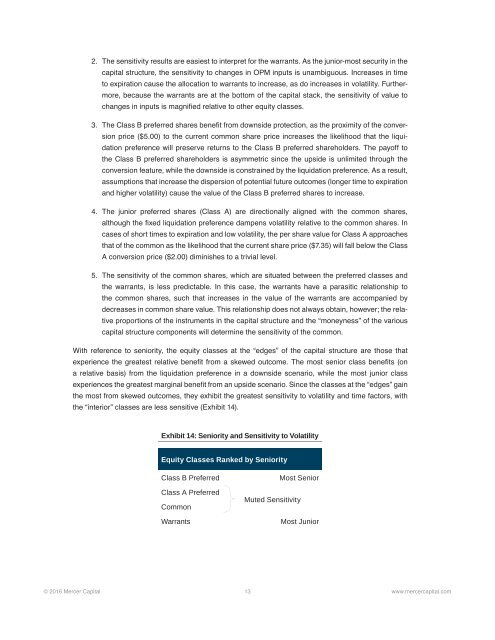A Layperson’s Guide to the Option Pricing Model
Article_Mercer-Capital-Guide-Option-Pricing-Model
Article_Mercer-Capital-Guide-Option-Pricing-Model
You also want an ePaper? Increase the reach of your titles
YUMPU automatically turns print PDFs into web optimized ePapers that Google loves.
2. The sensitivity results are easiest <strong>to</strong> interpret for <strong>the</strong> warrants. As <strong>the</strong> junior-most security in <strong>the</strong><br />
capital structure, <strong>the</strong> sensitivity <strong>to</strong> changes in OPM inputs is unambiguous. Increases in time<br />
<strong>to</strong> expiration cause <strong>the</strong> allocation <strong>to</strong> warrants <strong>to</strong> increase, as do increases in volatility. Fur<strong>the</strong>rmore,<br />
because <strong>the</strong> warrants are at <strong>the</strong> bot<strong>to</strong>m of <strong>the</strong> capital stack, <strong>the</strong> sensitivity of value <strong>to</strong><br />
changes in inputs is magnified relative <strong>to</strong> o<strong>the</strong>r equity classes.<br />
3. The Class B preferred shares benefit from downside protection, as <strong>the</strong> proximity of <strong>the</strong> conversion<br />
price ($5.00) <strong>to</strong> <strong>the</strong> current common share price increases <strong>the</strong> likelihood that <strong>the</strong> liquidation<br />
preference will preserve returns <strong>to</strong> <strong>the</strong> Class B preferred shareholders. The payoff <strong>to</strong><br />
<strong>the</strong> Class B preferred shareholders is asymmetric since <strong>the</strong> upside is unlimited through <strong>the</strong><br />
conversion feature, while <strong>the</strong> downside is constrained by <strong>the</strong> liquidation preference. As a result,<br />
assumptions that increase <strong>the</strong> dispersion of potential future outcomes (longer time <strong>to</strong> expiration<br />
and higher volatility) cause <strong>the</strong> value of <strong>the</strong> Class B preferred shares <strong>to</strong> increase.<br />
4. The junior preferred shares (Class A) are directionally aligned with <strong>the</strong> common shares,<br />
although <strong>the</strong> fixed liquidation preference dampens volatility relative <strong>to</strong> <strong>the</strong> common shares. In<br />
cases of short times <strong>to</strong> expiration and low volatility, <strong>the</strong> per share value for Class A approaches<br />
that of <strong>the</strong> common as <strong>the</strong> likelihood that <strong>the</strong> current share price ($7.35) will fall below <strong>the</strong> Class<br />
A conversion price ($2.00) diminishes <strong>to</strong> a trivial level.<br />
5. The sensitivity of <strong>the</strong> common shares, which are situated between <strong>the</strong> preferred classes and<br />
<strong>the</strong> warrants, is less predictable. In this case, <strong>the</strong> warrants have a parasitic relationship <strong>to</strong><br />
<strong>the</strong> common shares, such that increases in <strong>the</strong> value of <strong>the</strong> warrants are accompanied by<br />
decreases in common share value. This relationship does not always obtain, however; <strong>the</strong> relative<br />
proportions of <strong>the</strong> instruments in <strong>the</strong> capital structure and <strong>the</strong> “moneyness” of <strong>the</strong> various<br />
capital structure components will determine <strong>the</strong> sensitivity of <strong>the</strong> common.<br />
With reference <strong>to</strong> seniority, <strong>the</strong> equity classes at <strong>the</strong> “edges” of <strong>the</strong> capital structure are those that<br />
experience <strong>the</strong> greatest relative benefit from a skewed outcome. The most senior class benefits (on<br />
a relative basis) from <strong>the</strong> liquidation preference in a downside scenario, while <strong>the</strong> most junior class<br />
experiences <strong>the</strong> greatest marginal benefit from an upside scenario. Since <strong>the</strong> classes at <strong>the</strong> “edges” gain<br />
<strong>the</strong> most from skewed outcomes, <strong>the</strong>y exhibit <strong>the</strong> greatest sensitivity <strong>to</strong> volatility and time fac<strong>to</strong>rs, with<br />
<strong>the</strong> “interior” classes are less sensitive (Exhibit 14).<br />
Exhibit 14: Seniority and Sensitivity <strong>to</strong> Volatility<br />
Equity Classes Ranked by Seniority<br />
Class B Preferred<br />
Class A Preferred<br />
Common<br />
Warrants<br />
Most Senior<br />
Muted Sensitivity<br />
Most Junior<br />
© 2016 Mercer Capital 13 www.mercercapital.com


